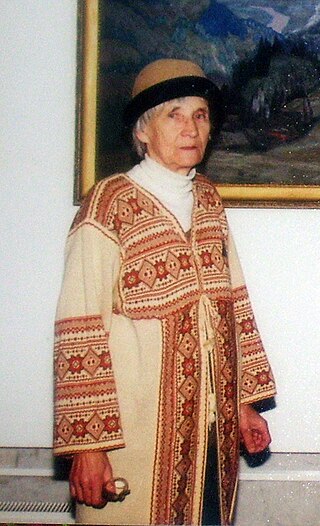
Egg decorating is the art or craft of decorating eggs. It has been a popular art form throughout history because of the attractive, smooth, oval shape of the egg, and the ancient associations with eggs as a religious and cultural symbol. Egg decorating has been associated with Easter in recent times, but was practiced independently by many ancient cultures.

Vegreville is a town in central Alberta, Canada. It is on Highway 16A approximately 103 km (64 mi) east of Edmonton, Alberta's capital city. It was incorporated as a town in 1906, and that year also saw the founding of the Vegreville Observer, a weekly newspaper for the region.

Ivano-Frankivsk Oblast, also referred to as Ivano-Frankivshchyna (Івано-Франківщина) or simply Frankivshchyna, is an oblast (region) in western Ukraine. Its administrative center is the city of Ivano-Frankivsk. It has a population of 1,351,822.

The Hutsuls are an East Slavic ethnic group spanning parts of western Ukraine and Romania.

Kolomyia, formerly known as Kolomea, is a city located on the Prut River in Ivano-Frankivsk Oblast (province), in western Ukraine. It serves as the administrative centre of Kolomyia Raion (district). The city rests approximately halfway between Ivano-Frankivsk and Chernivtsi, in the centre of the historical region of Pokuttya, with which it shares much of its history. Kolomyia hosts the administration of Kolomyia urban hromada, one of the hromadas of Ukraine. The population is 60,821.

Ukrainian National Museum (UNM) is located in the historical Ukrainian Village neighborhood of Chicago, United States. It is home to a plethora of Ukrainian artifacts, artwork, musical instruments, and embroidered folk costumes among its growing collection.

The tradition of egg decoration in Slavic cultures originated in pagan times, and was transformed by the process of religious syncretism into the Christian Easter egg. Over time, many new techniques were added. Some versions of these decorated eggs have retained their pagan symbolism, while others have added Christian symbols and motifs.

The Seven Wonders of Ukraine are seven historical and cultural monuments of Ukraine, which were chosen in the Seven Wonders of Ukraine contest held in July, 2007. This was the first public contest of that kind which was followed by the Seven Natural Wonders of Ukraine, the Seven Wonderful Routes of Ukraine, and the Seven Wonderful Castles of Ukraine. All nominated sites are publicly owned protected areas of at least regional level, available for tourism.

Ukrainian embroidery occupies an important place among the various branches of Ukrainian decorative arts. Embroidery has a rich history in Ukraine, and has long appeared in Ukrainian folk dress as well as played a part in traditional Ukrainian weddings and other celebrations. Appearing all across the country, Ukrainian embroidery varies depending on the region of origin. From Poltava, Kyiv, and Chernihiv in the east, to Volyn and Polissia in the northwest, to Bukovina, and the Hutsul area in the southwest, the designs have a long history which defines its ornamental motifs and compositions, as well as its favorite choice of colors and types of stitches.

Oleksa Dovbush was a famous Ukrainian outlaw in the Polish–Lithuanian Commonwealth, leader of the opryshky movement, who became a folk hero.

Prykarpattia is a Ukrainian term for Ciscarpathia, a physical geographical region for the northeastern Carpathian foothills.

The Art Museum of Prykarpattia, originally the Ivano-Frankivsk Regional Art Museum is a regional art museum located at 8 Maidan Andrey Sheptytskyi, Ivano-Frankivsk, Ukraine, in the former Church of Virgin Mary. It has one of the best collections of local religious art, and specializes in displaying works by local artists.

Hutsulshchyna is a national park in Ukraine. It is located in the Western Ukraine's Carpathian Mountains. Hutsulshchyna National Park was created on May 14, 2002, and it covers an area of 32,248 hectares. Administratively, it is located in Ivano-Frankivsk Oblast.

Halyna Olexandrivna Zubchenko was a Ukrainian painter, muralist, social activist and member of the Club of Creative Youth. She joined the Union of Artists of Ukraine in 1965.

Volodymyr Osypovych Shukhevych – was a Ukrainian public figure, writer, ethnographer and teacher.

The Yosafat KobrynskyiNational Museum of Hutsulshchyna and Pokuttia Folk Art is a museum in Kolomyia, Ukraine with a collection of more than 50,000 objects documenting the history and folk culture of Hutsulshchyna and Pokuttia regions.

National symbols are the sacred attributes for Ukrainian people. In Ukrainian graphics there exist a number of symbols and images from national songs, legends. Such symbols and imagery are used in national customs and rituals. They are reproduced in embroidery on national costumes, ritual cloth—rushnyks, painted on crockery, in forged products, in carving, in bas-relief house decoration, in hearth painting, pottery, engraving and also in Ukrainian traditional Easter eggs—pysanky.

Kosiv painted ceramics are traditional national Hutsul handicrafts, one of the varieties of Ukrainian ceramics. It is known for its pottery products such as various tableware, children's toys, souvenirs, stove tiles, decorative tiles. It is distinguished by a complex production technology and special drawings. Traditionally, ceramics from the village of Pistyn are also included in Kosiv ceramics.



























